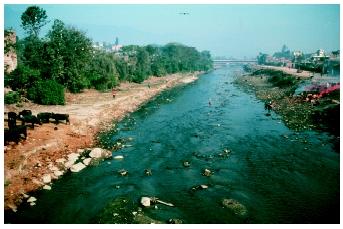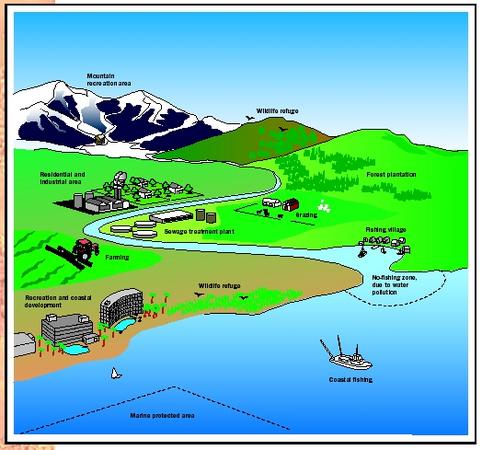Conservation

Biological diversity throughout the world is being threatened by human activity: species are being driven to the edge of extinction; biological communities are being degraded, fragmented, and destroyed; and the genetic variation within species is being lost as populations are reduced in size and lost. Conservation biology is a multidisciplinary science that has developed in response to this biodiversity crisis. Conservation biology has three goals: (1) to investigate and describe the diversity of the living world; (2) to understand the effects of human activities on species, communities, and ecosystems ; and (3) to develop practical interdisciplinary approaches to protecting and restoring biological diversity.
Conservation biology arose because none of the applied disciplines, such as forestry, fisheries and wildlife management, zoo and park management, and agriculture, were comprehensive enough individually to address the critical threats to biological diversity. In general, these applied disciplines have developed methods for managing a small range of species for the marketplace and recreation. Conservation biology complements these applied disciplines by providing a broader approach and by having the long-term preservation of biological diversity as its primary goal, with economic factors often secondary. The academic disciplines of population biology, ecology, taxonomy, landscape ecology, and genetics constitute the core of conservation biology, with increasing inputs from economics, law, philosophy, anthropology, and other related fields.
Origins in the United States
The need for the conservation of biological diversity has been recognized for centuries in North America, Europe, and other regions of the world. Religious and philosophical beliefs concerning the value of protecting species and wilderness are found in many cultures. In the United States, philosophers such as Ralph Waldo Emerson and Henry David Thoreau saw wild nature as an important element in human moral and spiritual development. Wilderness advocates such as John Muir and Aldo Leopold argued for preserving natural landscapes and maintaining the health of natural ecosystems.
The influential forester Gifford Pinchot developed the idea that commodities and qualities found in nature, including timber, clean water, wildlife, species diversity, and even beautiful landscapes, can be considered as natural resources, and that the goal of management is to use these natural resources to obtain the greatest good for the greatest number of people for the longest time. In the twenty-first century, the concepts of ecosystem management and sustainable development have extended these ideas by emphasizing management practices that maintain ecosystem health and wild species now and for future generations.
Conservation at Many Levels
All levels of biological diversity are necessary for the continued survival of species and natural communities, and all are important for people. The diversity of species includes the full range of organisms on Earth, from bacteria and protists, through the multicellular kingdoms of fungi, plants, and animals. The diversity of species provides people with resources and resource alternatives.

At the finest scale, genetic variation within species allows species to survive in the face of a changing environment; this genetic variation is also crucial for the continued efforts to improve domestic plants and animals, and for the rapidly developing biotechnology industry. On a larger scale, biological diversity includes the range of biological communities in which species live, and the ecosystem-level interactions with the physical and chemical environment. Biological communities provide beneficial services such as flood control, protection from soil erosion, the production of new plant material, and the filtering of air and water. As each one of these levels of biological diversity is degraded and destroyed, the natural fabric of the living world unravels and its value to people also diminishes.
Threats to Biological Diversity
The major threats to biological diversity are all caused directly or indirectly by an ever-increasing use of the world's resources by the exponentially expanding human population. Because more people require more resources for their livelihood, many scientists have argued that controlling human numbers is the key to protecting biological diversity. A more equitable distribution of natural resources throughout the world, and reducing the excessive consumption of natural resources by wealthy countries, such as the United States, are also important targets for conservation efforts.
The major threat to biological diversity is loss of habitat, and the most important means of protecting biological diversity is habitat preservation. Eighty-one percent of the endangered species in the United States are threatened by habitat destruction. Tropical rain forests, wetlands, coral reefs, and temperate grasslands are all being eliminated by human activity. Even when habitat still remains, it is increasingly fragmented by roads, power lines, fences, farms, ranches, residences, and other human activities that restrict wildlife movement and alter the local environment.
Air and water pollution can also eliminate susceptible species, even where the basic habitat structure remains. Sewage, industrial waste, and agricultural runoff can severely damage aquatic communities.

Biological communities can be harmed when exotic species are transported by people to a new place deliberately or accidentally. In many areas of the world introduced sheep, cattle, pigs, and goats have driven native plants to extinction; introduced invasive grasses, agricultural weeds, and ornamental plants have escaped into the surrounding landscapes, replacing the native species. Diseases spreading from one continent to another are a significant threat decimating important tree species in North America and birds in Hawaii.
Global climate change is an emerging threat to biological diversity. If Earth's climate continues to change and warm as scientists predict, many species will not be able to migrate or adapt and will go extinct.
Numerous bird, mammal, and fish species continue to be overharvested. Entire communities of large animals have been removed for consumption or sale resulting in "empty" forests, lakes, and oceans. Certain species have been targeted by collectors and represent special conservation problems, such as shellfish, butterflies, tropical and coral reef fish, orchids, and cacti and other succulent plants.
Conservation Efforts
The single most important method to protect biological diversity is to establish national parks, nature reserves, and other protected areas. Such efforts to protect biological diversity in their natural habitats are referred to as in situ or on-site conservation. Approximately 6 percent of the world's land surface is designated as protected, with more national parks being designated each year. Many new marine reserves are being established to protect the nursery grounds for commercial fish species and maintain high-quality areas for recreation and tourism.
To be effective at preserving biological diversity, protected areas must be well-designed, be as large as possible, and contain a variety of vegetation types and water sources. Management practices—such as regulating hunting, removing exotic species, and employing controlled burning to maintain habitat diversity—need to be developed and put into practice. One of the most rapidly developing areas of conservation management involves restoring native biological communities on degraded lands, often by planting the original species. Protected areas must be periodically monitored to make sure they are meeting their objectives.
Where species can no longer live in the wild due to continuing threats, they can be maintained in zoos and botanical gardens. In such places, information can be gathered about the biology of the species and the public can be educated about conservation issues. The goal of such captive breeding programs is to return species back into their original habitat, known as "reintroductions," once the original threat to the species has been identified and eliminated.
The greatest challenge involves developing projects in which conservation efforts are integrated with rural economic development. If local people benefit from conservation efforts through obtaining jobs, improved infrastructure , or new business and education opportunities, they will contribute to conservation objectives. But if local people perceive that the establishment of a protected area is harming their livelihood, they may actively oppose conservation efforts and damage the area.
Since the 1980s, conservation biology has become one of the most vibrant subject areas within biology. Enormous interest has led to whole new fields of knowledge being developed. However, conservation biologists are not simply content with developing new knowledge. The field of conservation biology will only be judged a success if this knowledge is used in a practical way to protect and restore the world's fragile biological diversity.
SEE ALSO Biodiversity ; Endangered Species ; Extinction ; Global Climate Change ; Invasive Species
Richard B. Primack
Bibliography
Akçakaya, H. Resit, Mark A. Burgman, and Lev R. Ginzburg. Applied Population Ecology: Principles and Computer Exercises Using RAMAS EcoLab. Sunderland, MA: Sinauer Associates, 1999.
Meffe, Gary C., and C. Ron Carroll. Principles of Conservation Biology. Sunderland, MA: Sinauer Associates, 1997.
Primack, Richard. A Primer of Conservation Biology, 2nd ed. Sunderland, MA: Sinauer Associates, 2000.
Wilson, Edward O. The Diversity of Life. Cambridge, MA: Belkap Press of Harvard University, 1992.
——, and Daniel L. Perlmann. Conserving Earth's Biodiversity. Washington, DC: Island Press, 1999.
Comment about this article, ask questions, or add new information about this topic: